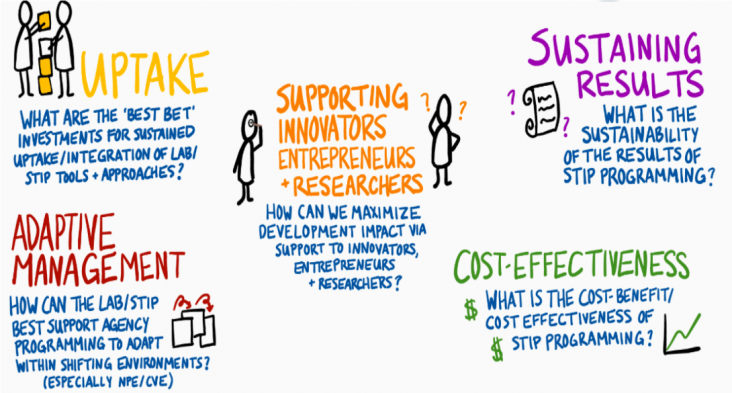- What We Do
- Agriculture and Food Security
- Democracy, Human Rights and Governance
- Economic Growth and Trade
- Education
- Environment and Global Climate Change
- Gender Equality and Women's Empowerment
- Global Health
- Humanitarian Assistance
- Transformation at USAID
- Water and Sanitation
- Working in Crises and Conflict
- U.S. Global Development Lab
Speeches Shim

Established in 2014, the U.S. Global Development Lab (“the Lab”) serves as an innovation hub within the U.S. Agency for International Development, helping the Agency harness advances in science, technology, innovation, and partnerships (STIP) that promise to accelerate development impact. The Lab’s two-part mission is to produce breakthrough development innovations and accelerate the transformation of the development enterprise. In support of this mission, the Lab generates, captures, shares, and uses evidence that helps us to understand what works, for whom, and under what circumstances.
By 2017, while the Lab had made marked progress in building the technical evidence base around STIP, no bureau-wide strategy or operational processes existed for coordinating these commitments. Internal collaboration and knowledge management remained largely siloed within Centers, with adaptations relegated to program or activity levels. The Lab’s Office of Evaluation and Impact Assessment (EIA) took the lead in facilitating a solution to these challenges; embarking on a CLA-driven process to develop and implement a cross-bureau learning agenda - the Lab Evaluation, Research, and Learning (ERL) Plan. Both a process and series of products, the initial iteration of the ERL Plan was organized around five bureau-wide learning questions, and ultimately: 1) prioritized, coordinated, and resourced cross-bureau ERL activities aligned with the Lab strategy, 2) centrally documented evidence relevant to STIP and the Lab, and 3) translated this evidence for use informing Lab decision-making and action.
By the end of summer 2019, the Lab had completed work addressing four of the five learning questions set out in the initial Plan, producing over 30 outputs documenting the related evidence base. Three Strategic Learning Reviews - a complement to the Lab’s semi-annual Portfolio Reviews - were held to translate and collectively prioritize evidence-based recommendations to options for action; nine of which were chosen and implemented by the Lab. An outcome harvest conducted as implementation was finalized validated six learning outcomes (evidence-based adaptations) were achieved. The ERL Plan has not only served to facilitate getting evidence into action, but has also improved CLA integration and organizational effectiveness in the Lab, including stronger internal collaboration, broader application of adaptive management, and more robust engagement around continuous learning and improvement.
QUESTION 1: What are the “best bet” investments for sustained uptake/ integration of Lab and STIP tools and approaches?
QUESTION 2: How can the Lab/ STIP best support Agency programming to adapt within shifting environments?
-
Question 2 Deep Dive - Real-time Data for Adaptive Management
-
Question 2 Deep Dive - Collaboration, Learning, and Adaptation
-
Question 2 Deep Dive - Monitoring, Evaluation, Research and Learning Integration
-
Blog post: “Help, I’m hiring new staff, and I want them to work adaptively!”
- A Guide to Hiring Adaptive Employees
QUESTION 3: How can we maximize development impact via support to innovators, entrepreneurs, and researchers?
QUESTION 4 (Dropped): What is the cost-benefit/ cost-effectiveness of STIP programming?
- Due to staffing and other resource constraints, Question 4 was dropped from the Lab Evaluation, Research, and Learning Plan in September 2018.
QUESTION 5: What is the sustainability of the results of STIP programming?
-
Handover Note Template
Intended for use in a time crunch, for the capture of critical information when staff depart in advance of new staff arrival. -
Knowledge Management Sustainability Tracker
Outlines a simple, four-step process to tracking and sharing the activities, relationships, and knowledge most critical to staff roles - not just at the end of their tenure; but throughout their term.
Additional Resources
-
Utilization-focused Learning Agenda Playbook
Documents ‘what’, ‘why’, and ‘how’ of the Lab’s approach, including links to tools, resources, and templates to support learning agenda design and implementation -
Blog post: Cracking the Evidence Conundrum: Four Ideas to Get People to Use Evidence
-
Blog post: Straight off the Shelf - Unpacking your utilization-focused learning agenda

Comment
Make a general inquiry or suggest an improvement.